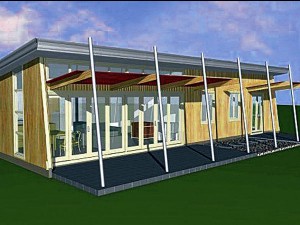When green means money

A BUILDING sketch designed by New Zealand’s Gabrielle Bell Architect is an excellent example of a structure that maximizes the entry of sunlight but at the same time offers shade that shelters against the harsh heat of the sun
Developers and home builders alike fear that the fight against climate change will cost millions, even billion of pesos. But they are now giving way to a different view: green can be the color of money.
While it’s true that many eco-friendly improvements—like updating all your lighting fixtures to compact fluorescent lamps or using tinting or awnings or canopies to windows that face the sun’s direct heat—do require some initial capital, one should look beyond costs first.
“The perception is that going green is for the wealthy, rich and famous. On the contrary, going green is actually all about saving money and resources and that it’s important for developers and homeowners to realize that in a span of just a few years the initial investment could be recovered through faster lease-up rates, rental premiums and increased market valuation of the project,” said architect Edgardo Reformado, chair of the Green Architecture Advocacy Philippines or GreenAP.
Nor do green-related savings necessarily take years to kick in as Reformado explained that while installing eco-friendly improvements or going for a green certification usually increases construction cost by 7 to 9 percent, such initial investment may be recovered in just three years.
Revenue generator
“The concept of going green may not appear as a revenue generator. But if you review your operations and spending and try to look at the business from a green perspective, you will find that it really is. For example, even if you have to increase the price, firms or homebuyers are still more likely to choose your project because of the savings they would eventually enjoy (electricity and water bills) as well as the much more comfortable living that awaits them,” Reformado said.
Since 2009, Reformado has led a group of like-minded architects devoted to promoting green architecture here in the Philippines.
“Green building skeptics continually argue that it’s difficult or even impossible to build green without paying a big cost premium, keeping developers as well as home builders from even trying. We are slowly changing this,” Reformado. said. He defined green or sustainable buildings as any structure that use key resources like energy, water, materials and land more efficiently than buildings that are just built according to code.
“With more natural light and better air quality, green buildings typically contribute to improved health, comfort, and productivity of the occupants,” explained Lilibeth Ducut-Abais, secretariat of GreenAP.
Green Forums
Abais, who is also the event coorganizer (through LA Ducut and Co.) of the Green Forum, explained that since the founding of GreenAP in 2009, they have organized several Green Forums that continually gather industry professionals, stakeholders and the public under one roof where participants are able to learn why this country should adopt and incorporate green architecture in designing and building any structure.
Abais informed that the 8th edition of the Green Forum will be held on Sept. 2-3 at the SMX Convention Center, Mall of Asia Complex, Pasay City.
The forum is one of the highlights of the four-day ManilaCon 11 Construction Show Manila (happening from Sept. 1 to 4), the country’s annual building and construction trade event on sustainability and innovations organized by LA Ducut and Co.
According to architect Miguel Guerrero III, deputy chair of the Green Forum and managing director of GreenAP, each edition of the Green Forum has a theme that is unique and runs in sequel with the others.
Guerrero said the theme of the 8th Green Forum will be “Cost and Cons of Going Green” and will be made up of nine lectures facilitated in by 11 guests speakers from here and abroad. It will be keynoted by Michael Lindfield who leads the Asian Development Bank’s Urban Development Specialist group.
He added that the 8th edition of the Green Forum aims to develop a common understanding of the issues and present practical solutions in designing and building sustainable communities in tropical countries like the Philippines.
Lecture
Representative of the principal architect of Zuellig Buildings in Makati City (which aims to achieve the first platinum certification for a commercial office building from the United States’ Leadership in Energy and Environmental Design) is scheduled to deliver a lecture as well as architect Dale Anderson, principal architect of architectural and engineering firm and specialist in sustainable-building design firm, BCRA.
Resource persons invited include Dr. Alvin Culaba of the De La Salle University; engineer Florigo Varona of the Integrated Electrical Engineers of the Philippines; architect Jinkie de Jesus, president of pioneering lighting design industry pioneering firm, Light Plan Inc.; engineer Virgilio Simbulan, chair of Board of Master Plumbers; engineer Mark Anthony Ver of leading projects firm Sinclair Knight Merz (Philippines); engineer Art Ranin of heavy civil engineering, building, marine works and contract mining firm, Leighton Contractors Inc; Guerrero III; and Carmelito Tatlonghari, LEED accredited professional.
Since only about 300 participants could be accommodated in the venue, Guerrero is advising them to register early at greenforum@manilacon.com.



















